Can Kalanchoe Survive Winter? (Here Is The Answer)
Kalanchoe, with its vibrant and eye-catching blooms, is a popular houseplant known for its ability to thrive in various conditions. However, when the colder months approach, many plant enthusiasts wonder if their beloved kalanchoe can survive in the winter.
In this article, we will explore this question in detail and provide insights into the factors affecting kalanchoe’s winter survival. Additionally, we will discuss effective ways to help your kalanchoe navigate through the challenges of winter dormancy.
Can Kalanchoe Survive Winter?
Yes, Kalanchoe plants can survive the winter with proper care and protection. These hardy succulents can withstand temperatures as low as 20 to 30 °F (-7 to -1°C) for a short period of time without suffering permanent damage. However, as soon as it gets cold outside and the thermometer shows less than 40°F (5 °C) degrees Celsius, you should bring your Kalanchoe inside, because in winter the pretty, thick-leaved plant prefers to be on the windowsill.
While some kalanchoe varieties may struggle with colder temperatures, others are more resilient and can withstand winter conditions with proper care.
While not fully hardy, some Kalanchoe varieties, including Kalanchoe blossfeldiana, Kalanchoe daigremontiana, Kalanchoe tomentosa, Kalanchoe luciae, Kalanchoe thyrsiflora, and Kalanchoe pumila, have shown tolerance to colder temperatures and light frosts.
Table: Kalanchoe Varieties Known to Tolerate Cold Temperatures
| Kalanchoe Variety | Hardiness Zone | Winter Survival Attributes |
|---|---|---|
| Kalanchoe blossfeldiana | 10-12 | Frost-tolerant, suitable for mild winters |
| Kalanchoe daigremontiana | 9-11 | Cold-hardy, can withstand light freezes |
| Kalanchoe tomentosa | 9-11 | Tolerates cooler temperatures |
| Kalanchoe luciae | 9-11 | Hardy succulent, handles frost well |
| Kalanchoe thyrsiflora | 9-11 | Withstands cold snaps and light freezes |
| Kalanchoe pumila | 7-10 | Cold-tolerant, survives light frosts |
Kalanchoe, being native to warm climates, is generally considered a tender perennial or a houseplant. Its ability to survive the winter depends on several factors, including the specific species or cultivar, environmental conditions, and the care provided.
Factors Affecting Kalanchoe Winter Survival
When it comes to the winter survival of kalanchoe, several factors come into play. Each of these factors has a unique impact on the ability of kalanchoe plants to withstand the challenges of the colder season.
From temperature sensitivity to light requirements and proper watering, understanding these factors can help you provide the necessary care for your kalanchoe during winter dormancy.
Temperature Sensitivity
Different kalanchoe species exhibit varying degrees of temperature sensitivity. Some are more cold-tolerant, while others prefer warmer environments. Extreme cold can damage the foliage, stems, and roots of kalanchoe plants, hindering their survival during winter.
From my research, Kalanchoe feels most comfortable at 62-66°F (17–19 °C) , but if the temperature in the room drops to 41-43°F (5–6 degrees Celsius), nothing will happen to the plant according to Clemson University.
| Symptoms of Cold Exposure in Kalanchoe: |
|---|
| Leaf discoloration (browning, blackening, or translucency) |
| Leaf wilting or drooping |
| Stunted growth |
| Leaf and stem damage (browning, softening, tissue death) |
| Brittle or damaged foliage |
| Delayed or inhibited flowering |
Light Requirements
Kalanchoe typically thrives in bright light conditions, but reduced daylight hours during winter can pose a challenge. Insufficient light can lead to leggy growth and weakened plants, making them more vulnerable to winter stress.
Watering and Humidity
Overwatering or keeping the soil excessively moist during winter can cause root rot and other fungal diseases. On the other hand, insufficient watering can lead to dehydration. Finding the right balance in watering is crucial to maintain the health of kalanchoe during winter.
Air Circulation
Good air circulation is important for preventing fungal diseases and maintaining overall plant health. Stagnant air can encourage the growth of pathogens that can harm kalanchoe plants, especially in enclosed spaces during winter.
How to Help Kalanchoe Survive Winter
Preparing your kalanchoe for winter dormancy is crucial to ensure its survival and well-being. By following a few simple steps, you can help your beloved plant thrive through the colder months.
From acclimatization to proper temperature control and lighting, here are some essential tips to keep your kalanchoe healthy during the winter.
Winter Preparation
When winter approaches, there are several steps you can take to help your kalanchoe successfully navigate through the colder months:
- Gradual Acclimatization: Give your kalanchoe some time to adjust to cooler temperatures. Start by gradually exposing it to slightly lower temperatures in the weeks leading up to winter. This process helps the plant adapt and reduces the risk of shock when the temperature drops.
- Pruning: Before winter sets in, it’s a good idea to prune your kalanchoe. Remove any dead or diseased parts to promote healthy growth and prevent the spread of pathogens during the dormant period.
- Soil and Pot Selection: Ensure your kalanchoe is planted in well-draining soil to prevent waterlogging and root rot. Select a pot with drainage holes that allows excess water to escape easily, keeping the roots healthy and happy.
Indoor Winter Care
Once winter arrives, you can provide specific care to help your kalanchoe thrive indoors:
- Temperature Control: Keep your kalanchoe in a room where the temperature stays between 55 and 75°F (13-24°C). Avoid placing it near drafts or areas prone to extreme temperature fluctuations, as these can stress the plant.
- Lighting: Kalanchoe loves bright light, so position it near a south or west-facing window to maximize sunlight exposure. If natural light is limited, you can supplement it with artificial grow lights to provide the necessary light intensity for healthy growth.
- Watering: Adjust your watering routine during winter. While you should reduce the frequency of watering, make sure not to let the soil completely dry out. Check the moisture level by feeling the top inch of the soil, and water when it feels dry. Remember to use room temperature water to avoid shocking the roots.
- Humidity: Maintaining moderate humidity levels around your kalanchoe can be beneficial. One way to do this is by placing a tray filled with water and pebbles near the plant. As the water evaporates, it increases the humidity in the surrounding area, providing a more suitable environment for your kalanchoe.
Examining Kalanchoe’s Hardiness Zones
It’s worth noting that different kalanchoe species have varying levels of cold hardiness. Hardiness zones are geographical regions that indicate the suitability of plants based on the average minimum winter temperature. Kalanchoe species generally fall within hardiness zones 10–12, which correspond to regions with mild winters and minimal frost.
According to my research, kalanchoe plants are typically recommended for optimal growth in USDA hardiness zones 10–12. These zones generally represent regions with mild to warm climates where the average minimum winter temperatures range from 30°F (-1°C) to 40°F (4°C) or higher.
If you live in an area with colder winters outside of the recommended hardiness zones, it might be challenging for your kalanchoe to survive outdoors year-round. In such cases, it’s best to keep them indoors during the winter or provide extra protection, like using frost covers or bringing them indoors temporarily.
How cold can kalanchoe tolerate?
Most Kalanchoe varieties can tolerate temperatures down to 40°F (4.4°C) without significant damage. Some varieties, such as Kalanchoe blossfeldiana, Kalanchoe daigremontiana, Kalanchoe tomentosa, Kalanchoe luciae, Kalanchoe thyrsiflora, and Kalanchoe pumila, are known to withstand milder winter conditions and can tolerate temperatures as low as 20–30°F (-7 to -1°C) without suffering permanent damage.
Even if many Kalanchoe species appreciate cooler temperatures of around 50°F (10°C) in winter, this does not apply to Kalanchoe blossfeldiana (Flaming Katy). They prefer warm temperatures around 68°F (20°C) all year round. It gets hard for them even at temperatures below 50°F (10°C), because they freeze really fast.
Is the Kalanchoe hardy?
Kalanchoe plants, are not fully hardy plants and should therefore be brought indoors when the temperature is below 59°F (15 degrees Celsius) according to University of Missouri. Most Kalanchoe varieties are native to warm regions and are adapted to thrive in mild to moderately warm temperatures.
However, as I presented above, there are some Kalanchoe varieties that exhibit a degree of cold tolerance and can withstand cooler temperatures or light frosts.
Therefore, these are not plants that you can plant in your garden flower bed. Most species die at temperatures below 41°F (5 degrees Celsius) at the latest. It is best to look at the plant portraits to see what minimum temperature your Kalanchoe needs.
In order to stimulate the formation of flowers, it needs short days with a maximum of 8 to 9 hours of daylight during the winter.
Conclusion
By understanding the factors influencing kalanchoe’s winter survival and implementing appropriate care strategies, you can increase the chances of your kalanchoe thriving throughout the winter season.
Remember, each kalanchoe plant is unique, so observe and adapt your care routine based on its specific needs. With a little extra attention, your kalanchoe can endure the winter months and continue to bring beauty and joy to your space.




